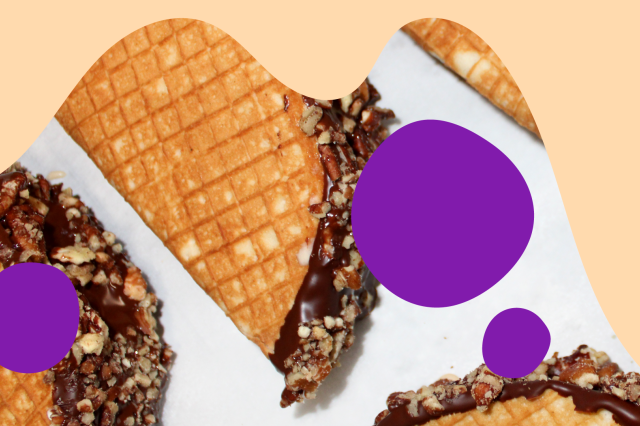
Tap in L.A.’s Deep-Rooted Love of Chocolate
Explore the collections of the Natural History Museum through the lens of chocolate!
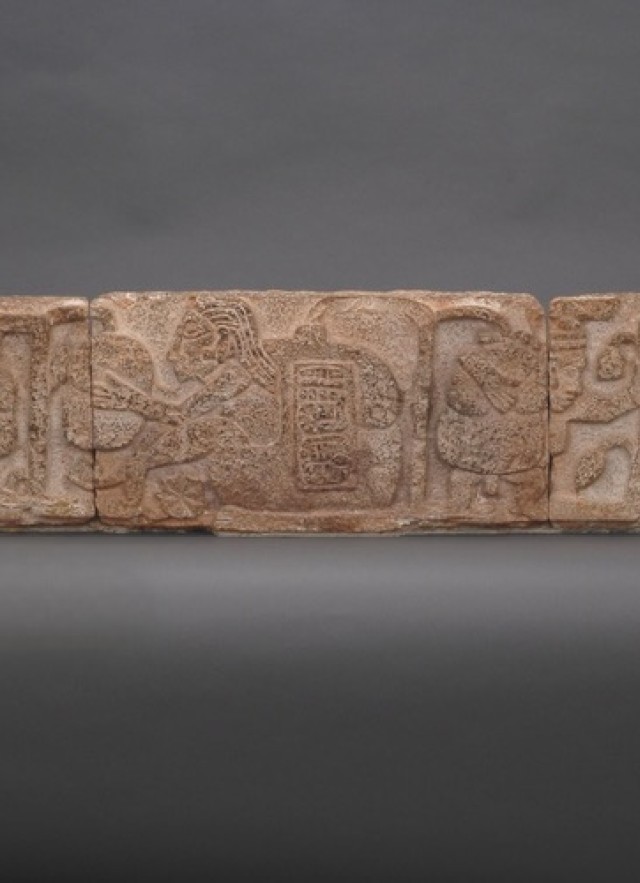
Published February 1, 2024
As the oldest natural history museum on the West Coast, we were bound to find some examples of chocolate in our collections. However, not all of our examples might be what you are expecting. From chocolate limpets (actual name!) to Ice Age beetles that look like delectable chocolate nibs, take a virtual tour below to see how this ubiquitous treat is represented in our collections.
To learn more about the global history of chocolate and how it came to be the treat we know today, Click here and scroll through our interactive story maps to view Chocolate's Timeless Journey.
Glyphs are characters used in systems of pictorial writing. Glyphs writings have been found on monumental sculpture, public buildings, murals, pottery, shell, obsidian, bone, wood, jade, and screenfold books called codices. Studying glyphs from Mesoamerica provides a fascinating
glimpse into the intricate social, religious, and economic fabric of these ancient cultures. What the picture below shows is a Maya glyph and a depiction of a man holding a cacao plant inscribed on a stone monument.
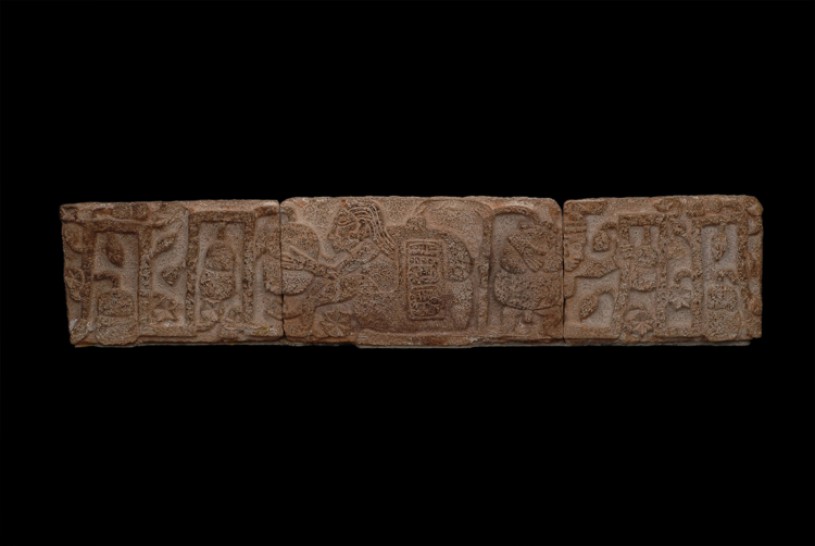
In many Latin American countries, molinillos are traditional kitchen tools for frothing or whisking, especially hot chocolate! They consist of a wooden handle attached to a carved and decorated wooden head with rings or spirals. The head is typically shaped like a ball or a cylinder, and the rings help in creating froth by rapidly spinning the molinillo between the hands. It is usually carved from a single piece of wood.
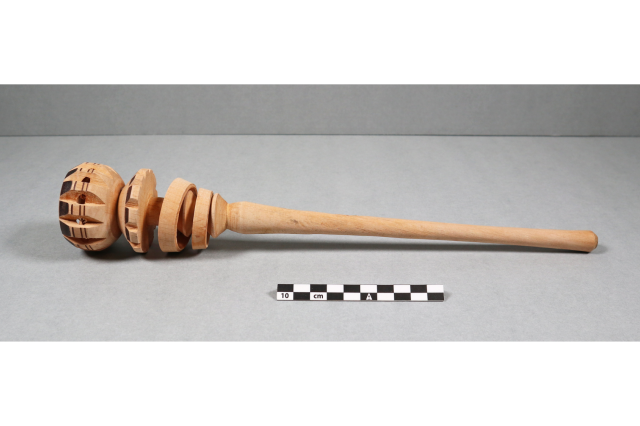
This turned wooden utensil is called a molinillo, a traditional Latin American whisk used in the preparation of chocolate drinks. This particular molinillo was purchased in 2002 from Guelaguetza restaurant in Los Angeles.

Natural History Museum of Los Angeles County - Anthropology (Ethnology) Collections
Molinillo from Mexico, collected 1865–1903
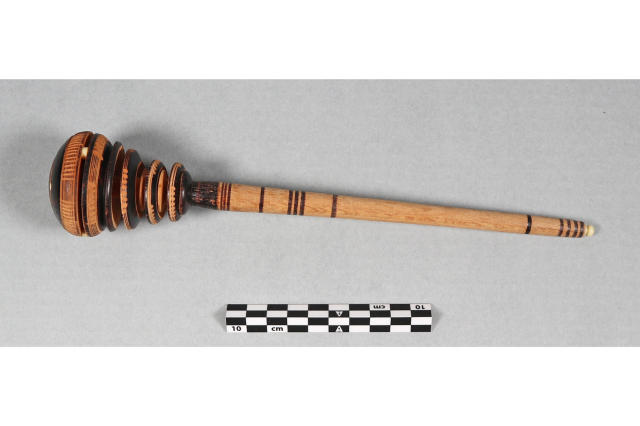
Natural History Museum of Los Angeles County - Anthropology (Ethnology) Collections
Molinillo from Michoacan, Mexico, collected by former Anthropology Curator, Dr. Margaret Hardin while on a research trip.
1 of 1
This turned wooden utensil is called a molinillo, a traditional Latin American whisk used in the preparation of chocolate drinks. This particular molinillo was purchased in 2002 from Guelaguetza restaurant in Los Angeles.
Molinillo from Mexico, collected 1865–1903
Natural History Museum of Los Angeles County - Anthropology (Ethnology) Collections
Molinillo from Michoacan, Mexico, collected by former Anthropology Curator, Dr. Margaret Hardin while on a research trip.
Natural History Museum of Los Angeles County - Anthropology (Ethnology) Collections
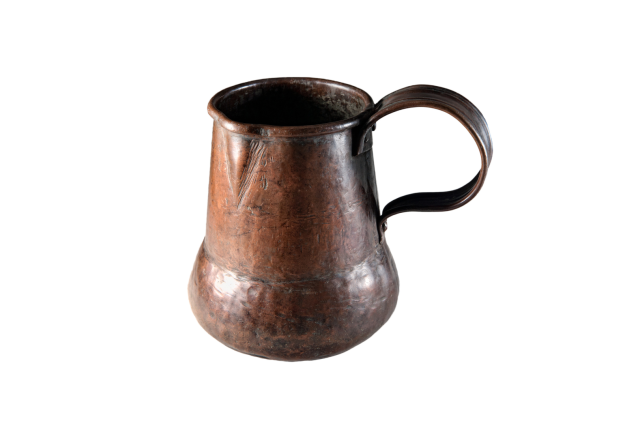
Natural History Museum of Los Angeles County - History (Material Culture)
This 1830 copper chocolate pot is displayed in the Becoming Los Angeles exhibition.

Natural History Museum of Los Angeles County - Anthropology (Ethnology) Collections
Maya hot chocolate cup, covered in fish glyphs. Maya fish glyphs represent the word chocolate. AD 600–900 It is is displayed in the Visible Vault exhibition.
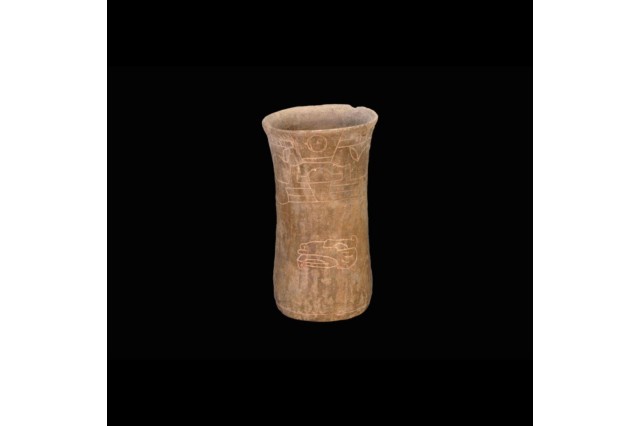
Natural History Museum of Los Angeles County - Anthropology (Ethnology) Collections
Cylindrical hot chocolate drinking vessel made of gray incised clay. Year, sign, and animal head glyphs are the subject of the incised design on the vessel. The head in profile is a glyph that depicts a rabbit or deer and represents one of the day signs in the ancient zapotec calendar. Monte Alban, ca. 300–200 BC. It is is displayed in the Visible Vault exhibition.
1 of 1
This 1830 copper chocolate pot is displayed in the Becoming Los Angeles exhibition.
Natural History Museum of Los Angeles County - History (Material Culture)
Maya hot chocolate cup, covered in fish glyphs. Maya fish glyphs represent the word chocolate. AD 600–900 It is is displayed in the Visible Vault exhibition.
Natural History Museum of Los Angeles County - Anthropology (Ethnology) Collections
Cylindrical hot chocolate drinking vessel made of gray incised clay. Year, sign, and animal head glyphs are the subject of the incised design on the vessel. The head in profile is a glyph that depicts a rabbit or deer and represents one of the day signs in the ancient zapotec calendar. Monte Alban, ca. 300–200 BC. It is is displayed in the Visible Vault exhibition.
Natural History Museum of Los Angeles County - Anthropology (Ethnology) Collections
The chocolate porcelain crab, Petrolisthes manimaculis, is a decapod crustacean that gets its name from its beautiful chocolate color, though this individual has lost its color from being preserved for fifty years. The crab epithet is a misnomer, as this animal is not a true crab. This fragile decapod lives up to its ‘porcelain’ name due to the ease at which it readily loses limbs to avoid predation and other dangers. In its vibrant splendor, a chocolate porcelain crab shows off the colors that give it its name. This species is an excellent example of carcinization, a form of convergent evolution in which non-crab crustaceans evolve a crab-like body plan.

Natural History Museum of Los Angeles County - Crustacea Collections
Chocolate porcelain crab in the collections | Petrolisthes manimaculis
1 of 1
Chocolate porcelain crab in the collections | Petrolisthes manimaculis
Natural History Museum of Los Angeles County - Crustacea Collections
Chocolate porcelain crab in the wild | Petrolisthes manimaculis
The vibrant hues of this Protoreaster nodosus have faded over decades of preservation. To properly appreciate its popular name, “Chocolate chip sea star,” one must view this handsome species in living color (second photo). Grazing herds of this gentle creature inhabit western Pacific coral reefs. Their protective, protuberant horns discourage marauding fish but fail to deter humans. As a result, these stars are exploited and endangered by the curio trade.

Natural History Museum of Los Angeles County - Echinoderm Collections
Chocolate chip sea star in the collections | Protoreaster nodosus
1 of 1
Chocolate chip sea star in the collections | Protoreaster nodosus
Natural History Museum of Los Angeles County - Echinoderm Collections
Chocolate chip sea star in the wild | Protoreaster nodosus
Another member of the cushion star family, Nidorellia armata, is likewise dubbed “chocolate chip sea star,” and for good reason. Distinctive black spikes and a resemblance to its namesake cookie are evident in the living animal (second photo) though these features faded in the museum specimen. This species is a common sight in the Eastern Pacific on submerged rocky reefs from the Gulf of California to Peru. It has a predilection for coralline algae (marine plants) and sponges. Surprisingly, it can digest and absorb these entrées externally, by extending an eversible stomach through its gaping mouth.
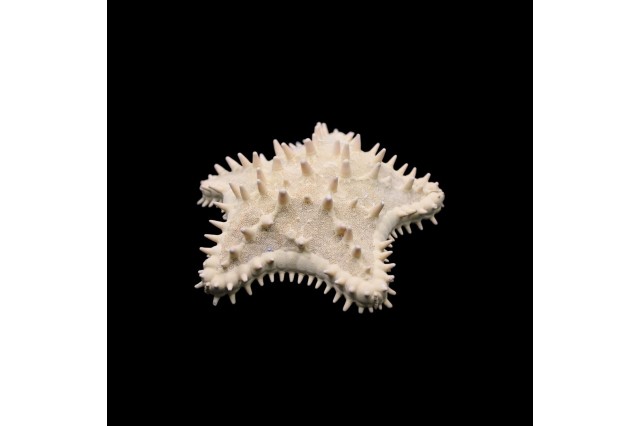
Natural History Museum of Los Angeles County - Echinoderm Collections
Chocolate chip sea star in the collections | Nidorellia armata
1 of 1
Chocolate chip sea star in the collections | Nidorellia armata
Natural History Museum of Los Angeles County - Echinoderm Collections
Chocolate chip sea star in wild | Nidorellia armata
Here, we have a juvenile Nile crocodile, Crocodylus niloticus, from our Herpetology collections who strongly resembles a particular member of the Hostess Gang—Chauncey Chocodile! Chauncey Chocodile once graced as the mascot for Hostess's chocolate-covered Twinkies. Take a trip down memory lane and click here to revisit the nostalgia with the 1980s commercial featuring Chauncey.
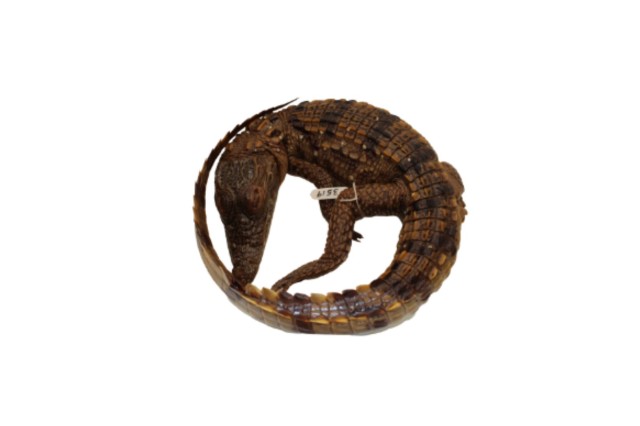
Natural History Museum of Los Angeles County - Herpetology Collections
Juvenile Nile crocodile in collection | Crocodylus niloticus

YouTube - Hostess Chocodiles commercial
Here we see Chauncey Chocodile from his 1980s commercial—you will definitely wait a while to eat a chocodile these days as Hostess has discontinued the once beloved chocolate treat.
1 of 1
Juvenile Nile crocodile in collection | Crocodylus niloticus
Natural History Museum of Los Angeles County - Herpetology Collections
Here we see Chauncey Chocodile from his 1980s commercial—you will definitely wait a while to eat a chocodile these days as Hostess has discontinued the once beloved chocolate treat.
YouTube - Hostess Chocodiles commercial
Malacology is the study of mollusks (snails, clams, octopods, etc.). Our Malacology collection is worldwide in scope and includes an estimated 500,000 lots containing approximately 4.5 million specimens. In tandem with the richness of our collection, the allusions to chocolate within it are equally varied and multifaceted. We have snails named after the Chocolate Mountains that they hail from and other mollusks named after their milk chocolate stripes and spots.
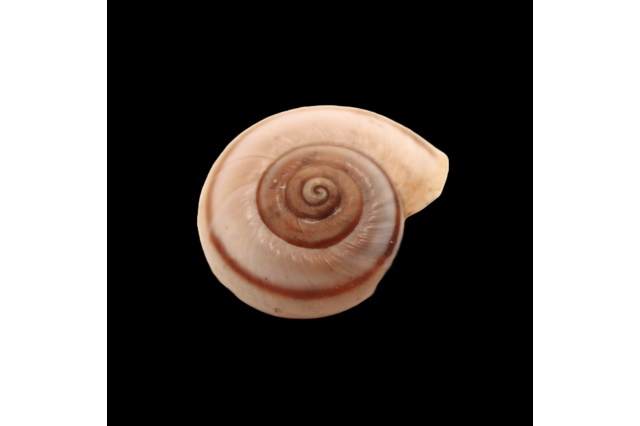
Natural History Museum of Los Angeles County - Malacology Collections, Dr. Jann Vendetti
Chocolate land snail in the collections | Eremarionta rowelli chocolata
This pale, chalky white land snail shell looks like milky hot chocolate with a swirl of chocolate syrup but was named “chocolata” after the Chocolate Mountains of Imperial County, California, where it was found. These mountains may have been named as such for the brown color of their vegetation during the dry season.
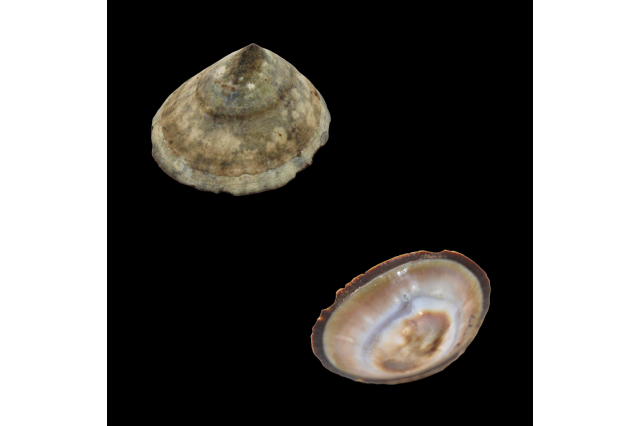
Natural History Museum of Los Angeles County - Malacology Collections, Dr. Jann Vendetti
Chocolate limpet in the collections | Lottia fenestrata
This California limpet’s species name ‘fenestrata’ means window in Latin, but its common name ‘chocolate limpet’ brings to mind the milk chocolate color of the center underside of the shell and the dark chocolate color of its inner edge.
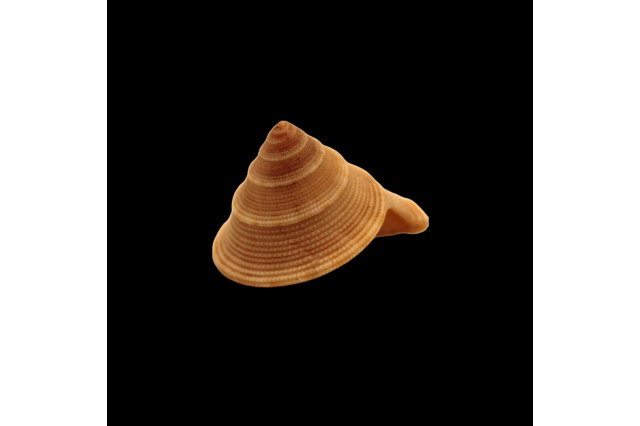
Natural History Museum of Los Angeles County - Malacology Collections, Dr. Jann Vendetti
Chocolate-lined top shell in the collections| Calliostoma javanicum
This snail hails from the Gulf of Mexico and Caribbean Sea but oddly its species author, the Frenchman Lamarck, described it as occurring in ‘les mers de Java’ or the sea of Java on the other side of the world. Less confusing is its common name, which invokes the milk chocolate-colored lines that cover the shell.
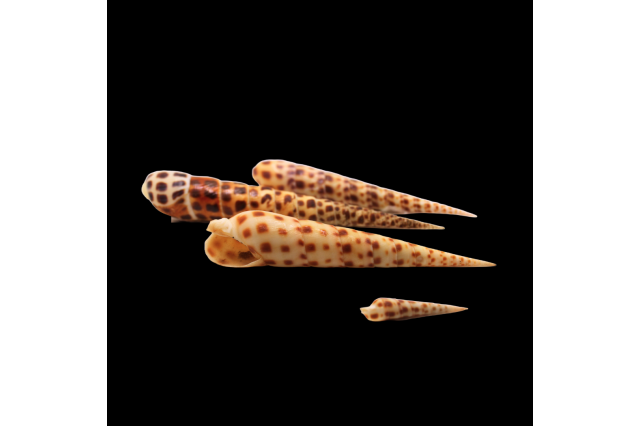
Natural History Museum of Los Angeles County - Malacology Collections, Dr. Jann Vendetti
Chocolate Spotted Auger | Terebra subulata
The range of this marine snail spans throughout the Western Pacific, including Indonesia and the Philippines. The father of taxonomy, Carl [or Carolus] Linnaeus, named it ‘subulata’ to indicate that the shell looked like an awl, a tool for piercing holes through leather. Its common name refers to the light to dark brown spots that cover the shell like square and rectangular chocolate chips.
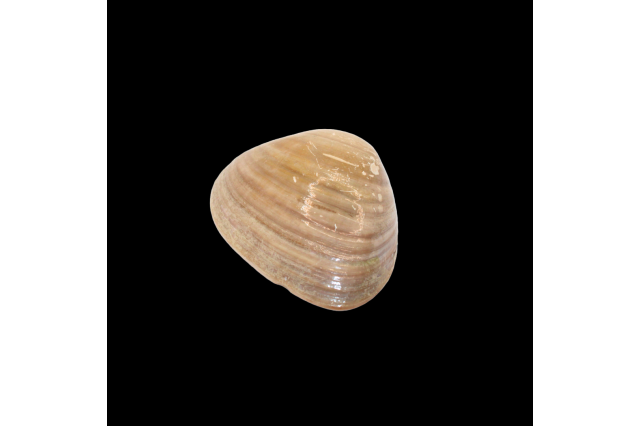
Natural History Museum of Los Angeles County - Malacology Collections, Dr. Jann Vendetti
Chocolate clam | Megapitaria squalida
Hailing from the Gulf of California to Central America, this clam boasts a remarkable variability in color, ranging from a light orange hue to a deep chocolate brown. In 1835, its species author bestowed the name "squalida," inspired by the term "squalid," reflecting its notably dull and dirty appearance. A more contemporary moniker, the chocolate clam, embraces its more enticing resemblance.
1 of 1
Chocolate land snail in the collections | Eremarionta rowelli chocolata
This pale, chalky white land snail shell looks like milky hot chocolate with a swirl of chocolate syrup but was named “chocolata” after the Chocolate Mountains of Imperial County, California, where it was found. These mountains may have been named as such for the brown color of their vegetation during the dry season.
Natural History Museum of Los Angeles County - Malacology Collections, Dr. Jann Vendetti
Chocolate limpet in the collections | Lottia fenestrata
This California limpet’s species name ‘fenestrata’ means window in Latin, but its common name ‘chocolate limpet’ brings to mind the milk chocolate color of the center underside of the shell and the dark chocolate color of its inner edge.
Natural History Museum of Los Angeles County - Malacology Collections, Dr. Jann Vendetti
Chocolate-lined top shell in the collections| Calliostoma javanicum
This snail hails from the Gulf of Mexico and Caribbean Sea but oddly its species author, the Frenchman Lamarck, described it as occurring in ‘les mers de Java’ or the sea of Java on the other side of the world. Less confusing is its common name, which invokes the milk chocolate-colored lines that cover the shell.
Natural History Museum of Los Angeles County - Malacology Collections, Dr. Jann Vendetti
Chocolate Spotted Auger | Terebra subulata
The range of this marine snail spans throughout the Western Pacific, including Indonesia and the Philippines. The father of taxonomy, Carl [or Carolus] Linnaeus, named it ‘subulata’ to indicate that the shell looked like an awl, a tool for piercing holes through leather. Its common name refers to the light to dark brown spots that cover the shell like square and rectangular chocolate chips.
Natural History Museum of Los Angeles County - Malacology Collections, Dr. Jann Vendetti
Chocolate clam | Megapitaria squalida
Hailing from the Gulf of California to Central America, this clam boasts a remarkable variability in color, ranging from a light orange hue to a deep chocolate brown. In 1835, its species author bestowed the name "squalida," inspired by the term "squalid," reflecting its notably dull and dirty appearance. A more contemporary moniker, the chocolate clam, embraces its more enticing resemblance.
Natural History Museum of Los Angeles County - Malacology Collections, Dr. Jann Vendetti
With a collection of 98,000 mammalian specimens, it's not surprising that we have found various connections to chocolate. Explore further to uncover the numerous ways mammals play a role in the production of chocolate, aiding pollinators, dispersers, and more.

Brown-throated three-toed sloth | Bradypus variegatus
Sloths eat up to 90 different species of plants including cacao pods and leaves (Theobroma cacao).

Natural History Museum of Los Angeles County - Mammalogy Collections
Spider and Capuchin monkey skulls | Atelus and Cebus
Capuchin (bottom) and spider monkeys (top) throughout Central and South America can assist cacao trees with new seedling production. The strong skin of the cacao pod changes to a bright orange color when ripe which attracts the monkeys to pick the pods and pound them on the branches to open them. The pod opens and because the seeds of the cacao beans within are bitter, the monkeys eat the exterior pulp and then spit the seeds down to the forest floor- where they can germinate into a new cacao seedling.
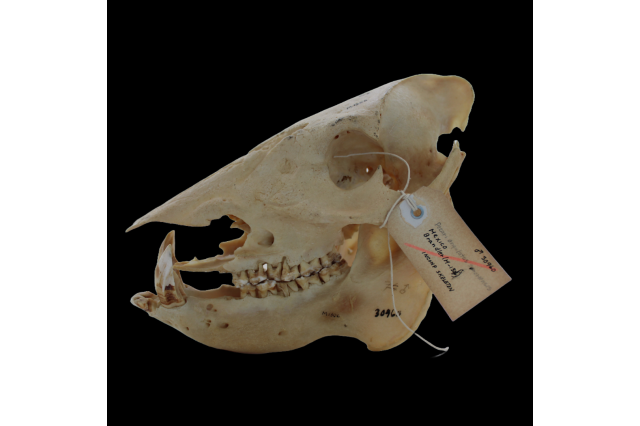
Natural History Museum of Los Angeles County - Mammalogy Collections
Chacoan peccary| Parachoerus wagneri
Peccaries are an important part of cocoa cultivation. Midge flies pollinate the flowers of the cocoa trees to produce beans from the tree, and the midge flies need mud wallows to breed in, and mud wallows are made by peccaries. Without peccaries to create mud, there are no midge flies to pollinate the trees. Visit the peccaries on display in the North American Mammal Hall.
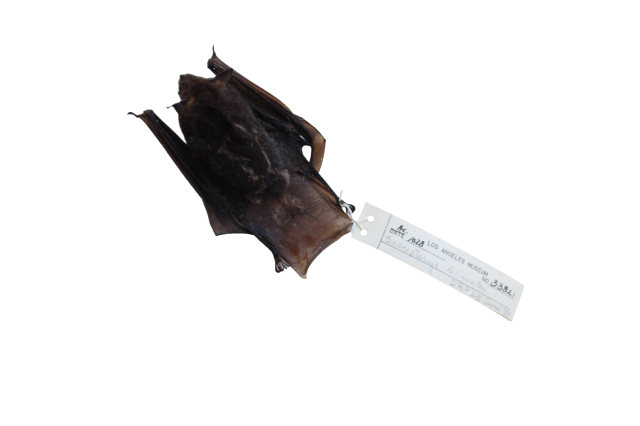
Natural History Museum of Los Angeles County - Mammalogy Collections
Bat | Chiroptera
Bats do not pollinate cacao but are important for cacao production. Bats consume and disperse cacao seeds but are also critical for consuming insect pests, in particular aphids and mealybugs, which feed on cacao. Research shows that cacao crop yields decreased by half when bats were excluded.
1 of 1
Brown-throated three-toed sloth | Bradypus variegatus
Sloths eat up to 90 different species of plants including cacao pods and leaves (Theobroma cacao).
Spider and Capuchin monkey skulls | Atelus and Cebus
Capuchin (bottom) and spider monkeys (top) throughout Central and South America can assist cacao trees with new seedling production. The strong skin of the cacao pod changes to a bright orange color when ripe which attracts the monkeys to pick the pods and pound them on the branches to open them. The pod opens and because the seeds of the cacao beans within are bitter, the monkeys eat the exterior pulp and then spit the seeds down to the forest floor- where they can germinate into a new cacao seedling.
Natural History Museum of Los Angeles County - Mammalogy Collections
Chacoan peccary| Parachoerus wagneri
Peccaries are an important part of cocoa cultivation. Midge flies pollinate the flowers of the cocoa trees to produce beans from the tree, and the midge flies need mud wallows to breed in, and mud wallows are made by peccaries. Without peccaries to create mud, there are no midge flies to pollinate the trees. Visit the peccaries on display in the North American Mammal Hall.
Natural History Museum of Los Angeles County - Mammalogy Collections
Bat | Chiroptera
Bats do not pollinate cacao but are important for cacao production. Bats consume and disperse cacao seeds but are also critical for consuming insect pests, in particular aphids and mealybugs, which feed on cacao. Research shows that cacao crop yields decreased by half when bats were excluded.
Natural History Museum of Los Angeles County - Mammalogy Collections

Natural History Museum of Los Angeles County - Ornithology Collections
Cocoa thrush | Turdus fumigatus
The cocoa thrush is a songbird found throughout South America, from eastern Colombia to central and eastern Brazil, as well as on the Caribbean island of Trinidad. It belongs to the thrush family which includes the American robin and Western bluebird. Their preferred habitat is dense forests, including cacao plantations, where they are seen foraging for small insects on the ground.
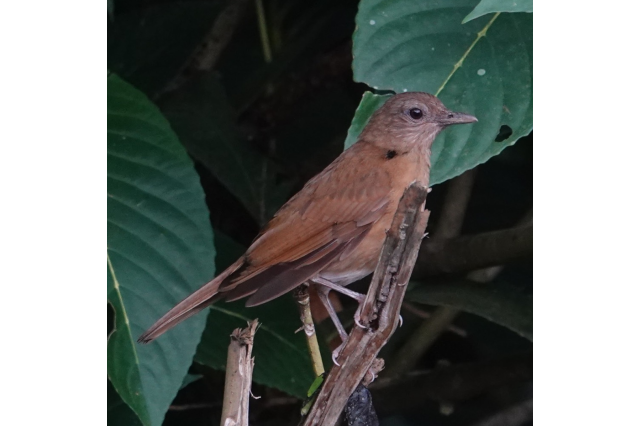
Cocoa thrush | Turdus fumigatus
The cocoa thrush is a songbird found throughout South America, from eastern Colombia to central and eastern Brazil, as well as on the Caribbean island of Trinidad. It belongs to the thrush family which includes the American robin and Western bluebird. Their preferred habitat is dense forests, including cacao plantations, where they are seen foraging for small insects on the ground.
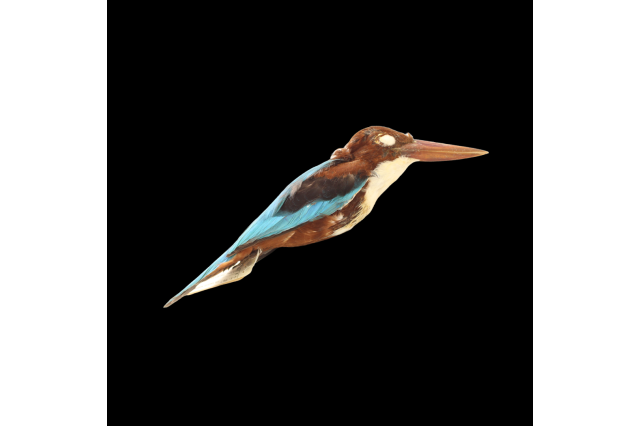
Natural History Museum of Los Angeles County - Ornithology Collections
Chocolate-backed kingfisher | Halcyon badia
The chocolate-backed kingfisher is found in western Africa in tropical rainforests, foraging on small insects and lizards, and excavating holes in termite nests to build their own nests. Despite the name, the chocolate color covers the head and extends all the way to its back. This brown color is produced by pigments, which contrasts the structural blue color seen in its wings and tail.
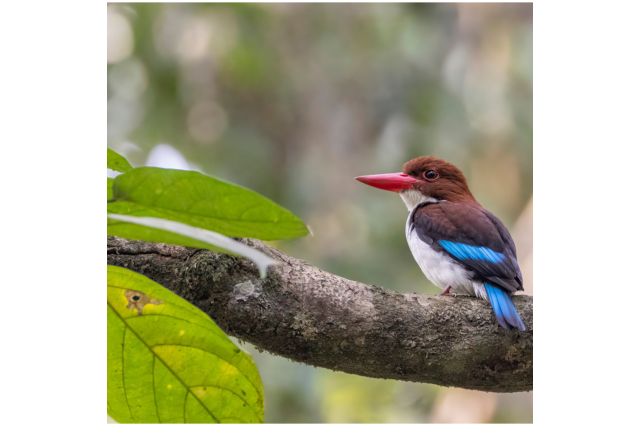
Chocolate-backed kingfisher | Halcyon badia
The chocolate-backed kingfisher is found in western Africa in tropical rainforests, foraging on small insects and lizards, and excavating holes in termite nests to build their own nests. Despite the name, the chocolate color covers the head and extends all the way to its back. This brown color is produced by pigments, which contrasts the structural blue color seen in its wings and tail.
1 of 1
Cocoa thrush | Turdus fumigatus
The cocoa thrush is a songbird found throughout South America, from eastern Colombia to central and eastern Brazil, as well as on the Caribbean island of Trinidad. It belongs to the thrush family which includes the American robin and Western bluebird. Their preferred habitat is dense forests, including cacao plantations, where they are seen foraging for small insects on the ground.
Natural History Museum of Los Angeles County - Ornithology Collections
Cocoa thrush | Turdus fumigatus
The cocoa thrush is a songbird found throughout South America, from eastern Colombia to central and eastern Brazil, as well as on the Caribbean island of Trinidad. It belongs to the thrush family which includes the American robin and Western bluebird. Their preferred habitat is dense forests, including cacao plantations, where they are seen foraging for small insects on the ground.
Chocolate-backed kingfisher | Halcyon badia
The chocolate-backed kingfisher is found in western Africa in tropical rainforests, foraging on small insects and lizards, and excavating holes in termite nests to build their own nests. Despite the name, the chocolate color covers the head and extends all the way to its back. This brown color is produced by pigments, which contrasts the structural blue color seen in its wings and tail.
Natural History Museum of Los Angeles County - Ornithology Collections
Chocolate-backed kingfisher | Halcyon badia
The chocolate-backed kingfisher is found in western Africa in tropical rainforests, foraging on small insects and lizards, and excavating holes in termite nests to build their own nests. Despite the name, the chocolate color covers the head and extends all the way to its back. This brown color is produced by pigments, which contrasts the structural blue color seen in its wings and tail.
Explore more stories of community and culture